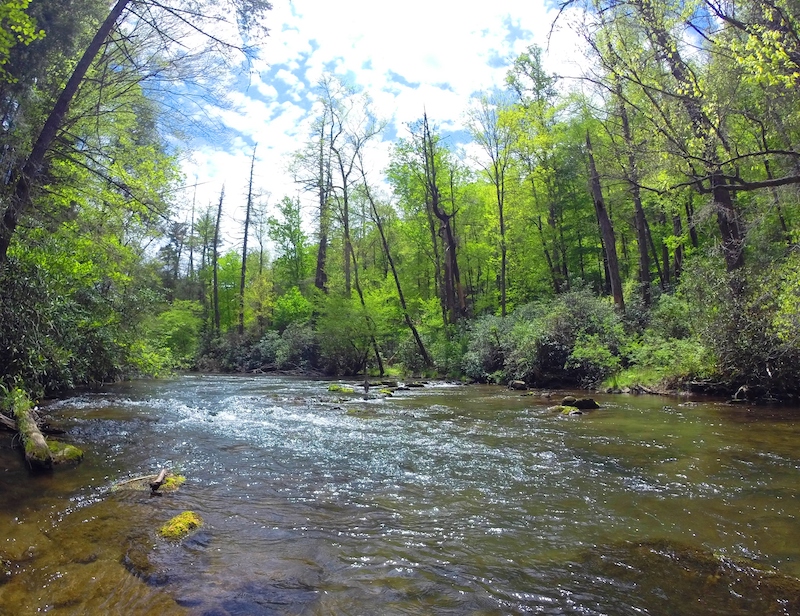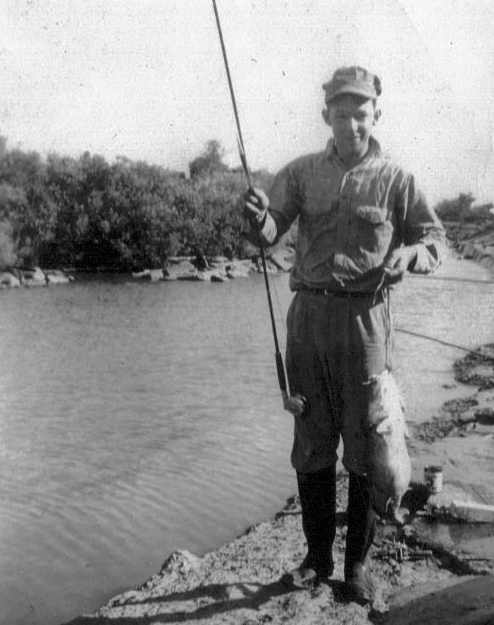The Clinch Knot is a common knot used throughout all types of fishing and was the first knot I ever learned to tie. It is used to attach the fly to the tippet. With a little practice, it is simple to tie and will serve you well in most trout fishing situations.
March Fishing Forecast

Mountains
While weather is all over the place around here and 80 degrees in February is just as likely as snow in May, I always call March the transition month. Winter is transitioning to spring and you tend to get sample of both seasons. When folks book trips for March, I always try to warn them that it’s a gamble. Not only can temperatures change on a dime and turn the fishing off, it tends to be a wetter month, so water levels can get way out of whack.
I’ve had some fantastic fishing in March, particularly toward the latter part of the month. When the stars align, we can see some of the first good hatches of the year with fish hungry after a winter of little food. It seems that every seasoned Smokies angler is on “Quill Gordon watch!” But a big cold front can delay the hatch and can lock a trout’s mouth tight as a drum.
What will this March hold? Only time will tell. We’re sure to see some really good fishing and some lousy fishing, too. When you live around here, you can pick your days. When you’re traveling here to fish, you just have to hope you’re here on one of the upswings.
In any case, most of the month will be spent fishing nymphs. Darker patterns do the best and a #12 Olive Hares Ear (or similar) is a pretty good imitation for the Quill Gordon nymphs that should be moving about. When water temperatures get into the 50’s for a significant part of the day, a few days in a row, our dry fly fishing should start to pick up. That’s probably going to be around the third week, but who knows?
Clinch
As usual, the fishery that does have good water temperatures year round and should fish well in the winter is cranking 2+ generators 24 hours a day. Last year was a tough one on the Clinch. A very wet spring resulted in very few days of low water. Unfortunately, this year is starting out the same way. Man, every year seems to be flood or drought. Is an “average” year too much to ask for?
Finding Feeding Trout
You can have the best gear and be a great caster, but it won’t mean a thing if you don’t know where to find feeding fish. We’ve covered a lot of these things separately in other articles, but here is a quick breakdown of the four things you really want to look for before you make that first cast.
Water temperature
A wild trout’s water temperature range for feeding is typically between 50 – 67 degrees. Ideal temperature is upper 50’s to low 60’s. There are plenty of exceptions that you can read about in Understanding Water Temperature, but this is a pretty good rule of thumb and should be your first consideration when trying to locate feeding trout.

If you’re not already familiar with a particular stream’s seasonal variations and trends, a stream thermometer will be your most useful tool. Submerge it for a minute in water that’s about 1-2 feet deep. If, for instance, it’s July and you get a reading of 68-degrees, you should, at the very least, seek out shadier parts of the stream. Ideally, you should try to get to a higher elevation where it’s a little cooler. If it’s March and you get a reading of 47-degrees, seek out sunnier places and, if possible, move to a lower elevation.
Part of this may require a little research on your part as well. If you’re fishing in a low elevation stream where the water temperature stays above 70-degrees for much of the year, there likely won’t be trout in there at all, even during colder months. Again, this is for wild trout. Some streams that might be too warm to support wild trout year round, could be stocked with trout during the colder months.
Depth
Once you have located an area with a suitable water temperature, you need to look for deeper water. We’re not talking about water that has to be over your head, but something at least a foot or two deep. In times when food is incredibly abundant like a heavy hatch, trout will sometimes feed in shallower water. But in general, they will choose water with a little more depth for more protection from predators.
Current
Even if you have ideal water temperature and adequate depth, trout don’t do a lot of feeding in still pools. And even when they do, they can be very difficult to locate and catch because they’re often cruising and feeding sporadically. A defined current is essentially a conveyor belt of food. Most feeding trout will be near currents, watching and waiting for food to come to them.

In currents with a slow to medium speed, trout will likely hold right in the middle of the current and on the edges. Hard currents with a lot of speed are a little different. A trout won’t hold in the middle of a hard current because it requires too much energy. Instead, the trout will be on the edges of these currents or between currents in seams and pockets.
Structure
A trout often has a few places in an area where he likes to hang out. He may have a favorite spot to feed and a spot under a rock where he likes to hide when he senses danger. Sometimes, you’ll find a place that looks perfect as far as depth and current speed go, but the stream bottom may be nothing but flat bedrock. These areas usually don’t hold many fish because there are few, if any, safe places. Try to look for a bottom with a lot of rocks where fish can hide.
Significant structure like fallen trees or large boulders often attracts the bigger fish, particularly if that spot meets all of the other criteria mentioned above. If you find any of the characteristics mentioned above, you’re apt to find a few feeding trout. When you locate a spot with ALL of these characteristics, you’ll likely find the most and/or the biggest trout.
Reusable Water Bottles
My grandfather always thought it was absurd that people bought water in plastic bottles. That someone would go to the store and pay for something that comes out of the kitchen sink, throw it away and do it again absolutely blew his mind. Even worse he thought, were all the plastic water bottles people didn’t throw away – the ones he regularly found at the places he hunted and fished.

No, he wasn’t an environmental activist. He was an insurance claims adjuster from a small town in the Midwest who rarely had anything at all to say about politics or activism. Instead, his perspective likely came partially from that common generational reluctance to embrace a different way of doing things. He was from the canteen generation. But his perspective was also greatly influenced by living through the Great Depression, when most folks simply couldn’t afford not to reuse everything.
My grandfather’s approach to the simple task of taking water into the woods was born purely out of necessity and common sense. Now there’s a whole lot of data that says he was right for reasons he knew at the time and for reasons he couldn’t possibly have foreseen: the overflowing landfills, the wasted oil, the wasted energy, the leaking toxins, the impact on wildlife and the mountains of plastic waste that end up in our streams, rivers, lakes and oceans.

However, my intent is not to write a detailed article on the specific detrimental impacts of single use plastics. There are an overwhelming number of articles and studies on the topic already. If you are unfamiliar with the problem or don’t believe there is a problem, I recommend taking a little time to research.
When it comes to fishing trips, I have always used reusable containers to carry my water. When I was a kid, I used a canteen like my grandfather did. In more recent years, I’ve been using hydration bladders or stainless steel water bottles. The choices today are vast from simple, inexpensive containers to those heavy, high dollar Yetis that will keep ice for days. As with any other piece of fly fishing gear, you just have to find what works best for you. All are better alternatives than buying water in single use plastic bottles.
Partly because I do consider myself an environmentalist and probably more because of the influence of my grandfather, I try to reduce waste as much as possible, whether it’s water bottles or anything else. If you have ever had one of my guide trip lunches, I provide real forks and cloth napkins not to be fancy (as some have commented), but because they are reusable. Lunches are also packed in reusable containers. There are a few things in the lunches that need to be wrapped either for practicality or sanitary reasons, but I’m proud to say the only thing that gets thrown away from one of my lunches is two pieces of cling wrap!
The fact is it would be way easier to pick up a boxed lunch full of disposable containers, paper napkins and plastic utensils and just throw it away at the end of the day. One of my least favorite things to do at the end of every day is to go home and clean all the lunch containers. Yes, it is WAY more work but to me, it is worth it.
I’m not trying to preach here or act superior because I produce less waste. I’ve used my share of disposable containers and I have certainly succumbed to the convenience of a single use plastic water bottle. After all, we do live in a world of convenience and sometimes you just don’t have a choice. But sometimes with just a little more effort, you do.
For years, while carrying my personal water in reusable containers on guide trips, I provided single use water bottles for clients. Yes, those water bottles were recycled after use but there are a lot of questions about the viability of recycling single use water bottles. I have always wanted to eliminate those plastic bottles altogether from my guide trips but thought I didn’t have a choice. It turns out I do. Much like my lunches, it will require a lot more work (and a little more expense) on my end, but like the lunches, I think it’s worth it.

Effective immediately, I will no longer be providing plastic water bottles on guided fishing trips. Instead, I am encouraging each client to provide his or her own reusable container for water. Many of my clients do this already. For anyone who does not have their own water/container, I will provide aluminum bottles of water. These bottles will be cleaned thoroughly at the end of each trip and reused for future trips.
Sure this will cost me a little more money and it will definitely be more work, but it’s worth it. As someone once told me, “I may not be able to make this world any better, but I sure as hell don’t have to make it worse!”

